Meals Ready to Eat have a bad reputation – three lies for the price of one, soldiers say – but they have a lot going for them as an emergency food supply.
Long-lasting and packed with energy, you can store them for years and know that, when it comes down to it, they’ll keep you going for a couple of weeks until you can find some real food again.
A case or two of MREs is a valuable addition to any prepper’s stockpile.
What if you can’t get hold of actual MREs, though? They can be expensive, especially if you get them from a reliable source.
Related: How to Make Delicious MREs at Home
MREs for sale on eBay have often been rescued from a dumpster on some Army base, they can be close to – or past – their disposal date, and you have no idea how they’ve been stored.
They could have been to Afghanistan and back in the freezing cold of a cargo plane, and left on a pallet beside a runway in the scorching sun in between.
That won’t ruin an MRE the way it will normal food, but it certainly isn’t going to help. Then, of course, you might have a food intolerance that’s triggered by ingredients in military MREs, or you might simply hate the taste of them.
Don’t panic, though – it is possible to make your own MREs at home. You can’t achieve the same shelf life and indestructibility of the military ones, but – especially if you have a dehydrator and a vacuum sealer – you can come pretty close. Here’s how I did it.
Planning Your Meals
US Army MREs come as one-meal packs, but I decided to do mine as 24-hour packs.
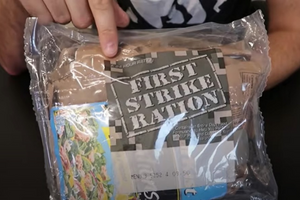
If necessary each one can be broken down into three individual meals.
My goal was for each MRE to have a breakfast that was easy to prepare but contained plenty of carbohydrates for energy, a lunch that would keep energy levels up but could be eaten on the go, and a cooked dinner.
On top of that I decided to include extra snacks, hot drinks, toilet paper, paper towels and matches. Each pack should be enough to keep you going for 24 hours, so if you’re planning a three-day trip just grab three of them from the shelf.
For breakfast meals I decided on cereal and a protein bar, which don’t need any preparation, and instant oatmeal, which just needs some boiling water and a quick stir. Lunch is crackers, snack or protein bar, candy and peanuts or similar.
For dinner I went with dehydrated sources of carbohydrate, livened up with some seasonings and dehydrated vegetables, plus long-life sausage to add more protein and fat. Here are the three menus I came up with:
Menu 1
Breakfast
• Cereal: I went for a presweetened brand (Cheerios) because if there’s no milk available they still taste OK dry.
• Instant oatmeal: This is quick and easy to prepare; just tip it into a canteen cup and add some boiling water.
• Protein bar: More energy, as well as protein, and something you can eat while you wait for the oatmeal.
Related: DIY Long-Lasting Energy Bars
Lunch/Snacks
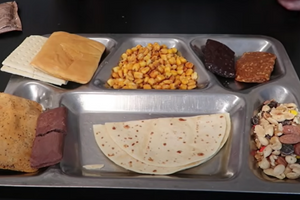 • Graham crackers: These are tasty, contain a decent amount of energy and add fat and fiber to your diet. I made up two packs of five crackers.
• Graham crackers: These are tasty, contain a decent amount of energy and add fat and fiber to your diet. I made up two packs of five crackers.
• Salted peanuts: If you’re working hard you need to keep your electrolytes up, and a cup of peanuts is a good way to get salt into your body.
• Protein bar
• Candy bar: A Snickers is a good source of energy, and also a small luxury you can keep in your pocket for when you need a morale boost.
• Haribo candy: “Morale-ibo” is a tasty source of sugar and energy.
Dinner
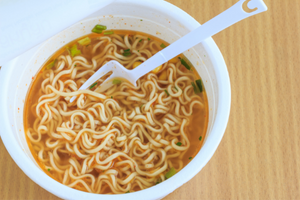
• Instant soup: This is quick and easy to prepare, and makes a great way to get some warmth inside you in a hurry if the weather’s bad.
Just tip into a cup and add hot water.
Related: The 30 Cents Survival Food That You Should Hoard
• Pasta: I took two packs of instant cup pasta and mixed them with a quarter cup of dried chopped onion and two tablespoons of grated Italian hard cheese.
To prepare, you just have to tip it into ¾ of a canteen cup of boiling water, or if you’re short of cookware just open the pouch, prop it against a rock and slowly pour in boiling water until it’s filled to an inch below the top. Leave it to stand for five minutes, stir well and eat.
• Sausage: I sliced two ounces of chorizo and vacuum sealed it in a separate pouch. This can be eaten on its own or added to the pasta.
Accessories
• Teabags
• Sugar: for the tea and oatmeal
• Toilet paper
• Paper towels
• Matches
Menu 2
Breakfast
• Protein flapjack: Even Cheerios get boring if you have them every day. This pack has a large protein flapjack instead.
• Instant oatmeal
Lunch
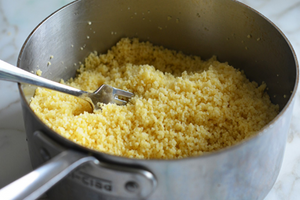 • Graham crackers: One pack of five, this time.
• Graham crackers: One pack of five, this time.
• Instant couscous with chicken and mushroom: Just add boiling water and let stand for five minutes.
• Protein bar
• Candy bar
• Haribo candy
Dinner
• Instant soup
• Mashed potato: One pack of instant mashed potato mix, with ¼ cup dried vegetables and 1Tsp Cajun spice mix.
• Snack sausages (two): These can be eaten as snacks or chopped and mixed into the mashed potato.
Menu 3
Breakfast
• Cereal
• Instant oatmeal
• Chocolate bar
Lunch
 • Graham crackers: one pack of five
• Graham crackers: one pack of five
• Bacon jerky: 3 slices
• Chocolate bars (two)
• Peanuts
• Haribo candy
Dinner
• Curried noodles: Two packs of ramen noodles, broken up and mixed with ¼ cup dried vegetables and 1 Tbsp English-style curry powder.
• Snack sausages (two)
• Candy bar
As far as possible, I vacuum-sealed all the components of each meal into their own pouch, then put all the pouches into one large outer package which I sealed without a vacuum. That makes it easy to break each pack into individual meals, for convenience.
This method does use a lot of vacuum pouches, but waterproof bags are always handy to have outdoors, and it also gives the meals some extra protection. Each 24-hour pack weighs around two pounds.
Obviously, all these meals rely on you having a dehydrator and vacuum sealer. These are gadgets I use a lot, and I think they’re extremely useful for any prepper, but what if you don’t have access to them but still need to make MREs?
Well, there are alternatives. They’re heavier and have less options, but they’ll still keep you going. Here’s my final menu:
Menu 4
Breakfast
• Protein flapjack
• Instant oatmeal x2
Lunch
• Ramen noodles: A pack of ramen can be turned into a hot meal in less than five minutes.
• Candy bar: Another Snickers won’t hurt.
• Oatmeal crackers: These have plenty fiber and energy. They also come in snack packs of six crackers, which is handy if you can’t seal your own packs.
• Hard candies
Dinner
• Instant soup
• Canned chilli: A canned meal is heavy, but it can also be relied on to last for years and if necessary you can eat it cold, straight out the can.
• Mashed potato: Instant mashed potato with cheese, so add some extra carbs.
This pack came in at a little under 2.5 pounds, which is slightly heavier than the others but still acceptable for a 24-hour ration. It was also the easiest to prepare, because everything in it came pre-portioned.
I packed each meal into one or more small Ziploc bags, then put all those in a heavy plastic bag that I then tightly wrapped in duct tape.
A few feet of extra duct tape can make all the difference in a survival situation, and it also gives the ration some protection. Every little edge helps!
You may also like:
 The Antibiotic Honey That Shouldn’t Be Missing From Your Stockpile
The Antibiotic Honey That Shouldn’t Be Missing From Your Stockpile
The U.S Army’s Forgotten Food Miracle (Video)
9 Scary FEMA Camp Facts You Must Know
Looming Economic Crisis Threatens To Push Millions Of Americans Into Starvation

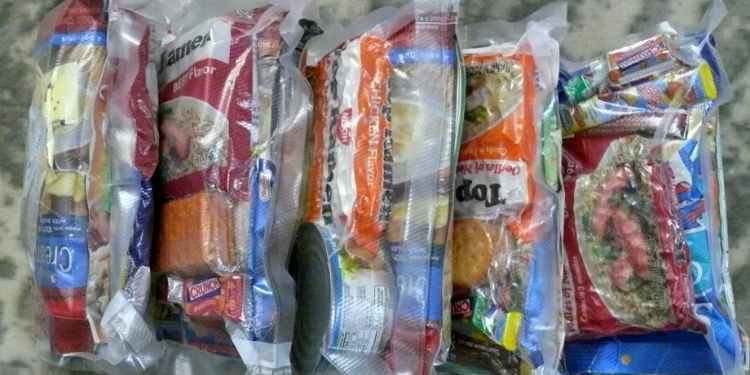













Some of that has to be cooked which isn’t a mre.
I’m not a food scientist…
But your recipes scream heart disease.
Exodus…I agree with you ‘on paper’ 100%. But for a short duration, it’s going to give you calories in a non-refrigeration scenario. Of course I would not want to eat this stuff long term….but if it’s all you have….
I definitely will not be eating all this salt laden items. Each person needs to plan specifically for their own nutritional needs. Also everyone seems to forget a simple but very important item, VITAMINS… There are so many that give you a days needs on vegetable/ fruit essentials. Small compact and designed with each meal, to balance out your emergency diet. Diabetics, those with high blood pressure, cancer, allergies all need to sit down and configure a health plan and pack their go bags accordingly. But this article is a good one for beginners, thank you for input.
Lance, salt is a necessary nutrient. In EOTW scenarios, you need the salt for water retention and you need sugar/calories for extra energy. In an emergency, we won’t necessarily be sitting in an air conditioned living room watching CNN and posting on askaprepper; we’ll more likely be doing actual work: gardening, building, tending animals, foraging, etc.
I don’t buy any sugar-free or no-salt-added vegetables or canned goods for storage. The way to manage your health is in portion control, not elimination of things you may need in an emergency.
I’m sorry but REALLY. This is SURVIVAL. I’m not worrying about heart disease. I’m thinking about how to keep THUGS away from my stash and other general survival stuff……you know….. shelter, self defense, keeping warm…….thing like that
Its good food but to make it simple enough a Jar of Peanut butter and a sealed bag of crackers goes a long way. Then add in some sugary candy for a glucky bump when your tired.. Some instant coffee and a spoon. You don’t need more then that for a MRE meal .
Keeping your damn Charms out of the camp as well.
I store almond butter too – and honey, which lasts forever in a glass container. PS: put honey on your peanut butter – or almond butter for a sweet, healthy surprise of flavor!!
Ever tried making cashew butter??? It is wonderful!
YUUCH!!!!!!!!!!!!!!!!!!!!!!!!!!!!
What is a protien flapjack?
Protein flapjack:
add protein powder or collagen powder to the pancake batter -Also, add extra eggs to the batter (one for each pancake!). NB: For fluffy, flexible cakes, use YOGHURT INSTEAD OF MILK!
EASIER: buy KODIAK pancake/flapjack batter!!!
( Look for the image of a big Bear’s head on the box)
High protein, delicious – they even have dark chocolate and chocolate chip batter. Just add water. Wunderbar!!?
Thanks! We just happen to have Kodiak mix.
Probably 40 years ago, I was trying to figure out better ways for protein storage so I experimented with adding ground soybeans into bread recipes and pancake recipes. There was no Internet back then so I didn’t know about soy-boys and man-boobs so I’m just glad that it all tasted like crap and we decided to can hamburger instead.
This had the makings of a great article. ++ on picking things you actually eat. Really like the idea of using full day menu planning. Sadly many of the chosen components will need replacing in short order, candy bars, things with fats, oils, nuts. If “bugging in”, why not choose more shelf-stable items or canned goods? Even if bugging out, heavier packages would be consumed daily, lighten-ing your load. Good article, makes me think, especially on how to integrate ramen into the mix.
Make a few suggestions for “more shelf-stable items or canned goods.”
1. Canned chickpeas -garbanzo beans (with or without salt- or even organic!) Roman soldiers relied on the faithful chickpeas while on their 50 mike marches. Cumin & dehydrated garlic/onion for extra flavor. High in protein & in all important fiber!!!
2. Canned lentils…dark.raisins (go great together!!)
3. Canned pineapple in own juice: tasty & great for digestion
4. Peanut butter (Trader Joes brand = the healthiest & best) and
Almond butter (get organic if possible)
5. Honey!!! makes almost everything more cheerful. And don’t forget! the more expensive Manuka honey is also a wound disinfectant/healer… Historically, many troops went nowhere without it!
DoMo, shelf stability should not be a huge concern unless you’re counting on MREs for long-term food. I do conceptually similar packages to this article, some of the same foods even, for our 3-day emergency bags.
If you’re planning this style of food for your emergency (bugout) bags, then it’s a small amount of food and you can just rotate it out every couple months. In years past, we’d pick a weekend and eat our outgoing emergency kit foods. Now I’m more likely to toss them – not because I don’t like them, I use foods all that I like, but I toss them because I know I can eat them and have been eating similar things anyway. I don’t need to prove I can so I go for the convenience route.
I forgot to mention, the big problem with canned foods is the weight. Just like packaged soups that you have to carry water to cook – too much weight for an emergency bag unless you plan and weigh, and test-carry, your bags and make sure you can carry it. Graham crackers, protein bars, etc., weigh far less and don’t need water to prepare.
If you pick up a few cans of dehydrated beef and chicken, along with the vegetables mentioned, they go really well into the crushed ramen meal. It’s not dinner at the steak house, but in a pinch with an empty stomach, it’s great. And kids love it 🙂
David
Sometimes, when very hungry …and
not wanting to make more dishes dirty ( !!! ) I do munch on 1/2 packet of ramen like some people munch on chips…
ramen does soften the moment one chews…and one gets protein, some fat but very little salt (when not opening those msg-salt paks)
Just sayin’…?
Tonyg, it is my firm plan to bug in but I also keep a 3-day bag for bugging out. My health, my security, my wife’s health all say for us to bug in but we do prepare for the possibility that something happens and we just have to bug out – even if it is just for a few days and return home again.
Our bug-in plan is significantly different, even though still partly the same, as our bug-out plan. For bugging in, we store a lot of our water in our canned foods – both store-bought and home-canned. For bugging out, we opt for better control of weight – dryer foods and carrying 2 bottles of water per person per day. We carry water filters for obtaining more water if available but we have at least short-term-survivable amounts of water.
For bugging in, we have luxurious levels of meats, water, flavorings, side-dishes, etcetera but, for bugging-out, we want just to make sure we come out of a 3-day emergency alive.
Crush the noodles up and save the spice packet with it.
Just wondering, how long will the chorizo and sausages last when vacuum sealed?
It will only last days. Once it is opened, even if you vacuum pack it, the clock is running. That’s the one part of this article about which I strongly disagree.
Dollar General usually has some small – 2 to 4 – ounce beef sticks or sausages. At Christmas time, Hickory Farms sells snack sized cheese and sausages, etc. Big Lots has 3 ounce or so cheese wheels maybe all year – in other words I got some after Christmas and they had a new shipment (new dates, etc.) just a few weeks ago when I bought some more. Walmart has some really good Italian-style sausages at the deli counter that are about 7 ounces. They’ve doubled in price from $3.50 to $7.00 in the past two years but for emergency preparedness, it’s worth buying a few. All of these items stay at room temperature on the shelf at the stores.
I regularly buy all of these products for my emergency kits. I’ve stored them all at room temperature and eaten them after months but before their best-by dates. When I mentioned tossing my emergency pack foods, I didn’t mean these items; these I eat. I toss things like graham crackers, club crackers, protein bars, etc. These sausages and cheeses are all very delicious and I use them regularly in my good-times diet as well.
I would suggest researching both Cold Weather MRES ( White package ) as well as LRP ( We called em Lurps ) MRES to get some more ideas
Those where pretty decent and the main meal was MT house something…. Decent if you have time to heat up water.
Whenever I buy food and have ‘leftovers’ at the end of the month, I dehydrate it. Then I vacuum seal it. But when I vacuum seal, the meal has potatoes, mushrooms, royg bell peppers etc. Not every meal is the same. Sometimes I add a package of jerky. Makes a good meal. If I add too much water to undehydrate everything, it’s soup. If I just enough water, it’s casserole.
Have a great day everyone.
JoAnn
these might be DIY quick convenience high-carb camping/hiking meals, but they are not MRE’s. For easy to make DIY travel “meals”, easy to carry “road food”, I would choose other items that are just as convenient but provide better nutrition and calories, such as fortified protein bars (not the low nutrition granola snack bars), peanut butter, and crackers that come in small sealed packaging (Sky Flakes are excellent for travel), dried fruits like raisins, mangos, and banana chips, shelled nuts like almonds, and maybe dry cereals like Cheerios for the fiber, vitamins, and minerals would be okay depending on packing space, instant mix drinks like coffee, iced tea, and flavored powders, hard candies, and always have a few of the 2000+ or more calorie survival bars when traveling for when you run out of your other DIY food.
This is a good article with ideas that each person can adapt to their own needs. One point to consider is that a person’s likes and dislikes might change during a stressful time. The author mentioned choosing cheerios that are sugar coated. It could be that the plain non-sugared cheerios settle better during a stressful time. There are a lot of good ideas in the comment section about how to kick up the food value but, keep in mind that sometimes under stress something that is easier and lighter to eat is of value.
Maybe, with all of the good high food value packets, throw in a couple of packets that are super light in value and easier to tolerate when things aren’t going well in your digestive system.
When packing the instant coffee, add a shrink-wrapped packet of organic milk based baby formula instead of artificial creamer. The baby formula, if it’s good quality (expensive) and not just a mix of high fructose corn syrup and artificial ingredients as most of them are, can give a little extra boost of nutrition. When I was helping someone who had more or less quit eating any food, I would add a high quality bit of baby formula to his coffee.
Recently, I wasn’t able to leave home for a stretch of time and ran out of milk for my coffee so I opened up a container of prepper style instant milk. What horrible stuff. It has the consistency of plaster of paris and didn’t taste much different. Fortunately, I had some Ovaltine. I added a bit of Ovaltine to the “plaster of paris” milk and it became usable in my coffee.
if you’re setting up something like these ersatz MREs or packing the real thing >> make sure to include the MRE heaters and the new beverage bags – breaking out a stove defeats half the reasoning behind the MRE concept ….
The author presents some great ideas, and I like the idea of sticking to the concept of keeping your homemade packets close to what you will find in a prepackaged MRI packet.
Here are some other suggestions.
Individual packets of dehydrated or dried fruit, instead of candy. These supply sugar as well as fiber and vitamins. If you want candy, Lifesavers or fun packs of M&Ms are good and won’t melt like a regular candy bar.
Slim Jims or jerky may be a better storing option than the sliced chorizo. You can also get shelf stable foil packets of Spam and tuna and other fish, some already seasoned or with a dressing of some sort. Also available are individual packets of peanut butter made like condiment packets, and I believe I’ve seen hummus as well (not sure about that) in single serving cups.
Individual packets of crackers, cookies, pretzels are available for carbs. Homemade options that keep well are our old friend hardtack and pilot crackers. Anzac cookies were popular with Aussie and Kiwi troops during WWII and you can find the recipe online. These are supposed to keep/travel well and are pretty nutritious for a cookie. If you don’t want to bake, try Belvita breakfast cookies. Homemade oatmeal cookies with dried fruit keep unrefrigerated for about 4-6 days, depending on how you store them.
Propel makes an electrolyte drink mix that comes in individual serving packets that can be added to a bottle of water for flavor and to replenish your body if you’re sweating or have diarrhea. Good to keep on hand during flu season as well.
A life straw or water purification tablets may have been considered obvious, but should be mentioned for the sake of the newcomers.
Wet Naps are also a good addition to help maintain hygiene.
Hope my suggestions help give you some ideas.?
Also, freeze dried meat and veggies can be packaged up to dress up your ramen. These rehydrate well and don’t require the cooking time of dehydrated options.
Not sure if this was already mentioned but the foil packs of tuna and chicken etc are a lighter weight ‘canned meats’ option.
Tuna pouches are lightweight and great on crackers right out of the pouch with no prep-work.
ok guys really!
There has to be a better menu then this! we have a whole world of food to research and my Wife has worked 20 years to get me off the Military Diet and the thought of an old Nasty MRE
makes me cringe. However! You have put me on the path. Now I need to find Prepper Food I can feed to a 3-star Chef that will have a long shelf life… Wish me Luck she’s a nonprepper of course so these will be discised as weekend camping food, and where is the protein the meats dried or sausage eggs? but that goes with other Variables as well TANK’S alot
I have made my own MRE’s using freeze dried burgers, steak chunks, chicken, ground beef, shrimp, and ham, etc. I use my favorite recipes and remake using dry items (just add water items). I even made shrimp Scampi using dehydrated cooked Lugueni, powdered butter, dry real lemon, etc. You can fing just about any item in freeze dried, dehydrated, or powdered forms. I’ve made over 30 types of meals that I really enjoy. As of today I have 8 months worth of meals…breakfast, lunch, and dinner. Also portioned out powdered drink mix too.
To add more flavor and also vitamins, add dehydrated vegetables to your ramen. Also, Nutritional yeast, non fortified will give added protein.
There are online pharmacies where you can buy Rx’s from Canada at a huge discount. You need a valid prescription from your Doctor (mine is a Homeopathic Dr) I just ordered farxiga for under $3.50 per pill (The cost, without insurance is about $500. for 30 pills= $almost $17. per pill)
One such company is Polarmeds.com
This is how I intend to have reserve Rx’s in case/when supply chain goes away.
I would just like to say that 5 gallon water containers aren’t always the best. I bought several 5 gallon containers that now sit where I put them, as at 70, I can’t lift them!!! I can’t even lift them to use to flush the toilet as they are simply too heavy…and they are well past the 1 year turn-around. There is no way to remove water until they are light enough for me to use…so I’m stuck. I bought 2.5 and 3 gallon containers, which I CAN carry. So be aware of the weight of things you buy and make sure you have ways to lift/move heavy items!
MRE’s aren’t easily available. (and they are often really old and often yucky..I know, I’ve tried a couple. You can make meals in jars, if you have dehydrated and/or freeze dried foods…Or can your recipes…meat is easily canned and safe if you follow proper procedure using a pressure CANNER (NOT cooker, or Instant Pot)
It’s easy to either dehydrate and put meals in canning jars and can or can your leftovers. For those who have access to a freeze dryer or can afford freeze dried foods, making shelf stable meals in jars (or mylar, if you want) is a great way to put away food. You will need a FoodSaver and a jar kit to remove air from the jars…There are lots of options. Even manual air removal… I have about 5 different vacuum systems to remove air from canning jars.
OOPS! This comment above was meant for another post:
“Items I Stockpile Because I Don’t Trust the Government”